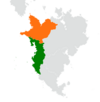Portal:Ajax/Article: Difference between revisions
No edit summary |
(Ajax article spotlight for October 2021) |
||
| Line 1: | Line 1: | ||
<div style="float:left;margin:0.5em 0.9em 0.4em 0;">[[File: | <div style="float:left;margin:0.5em 0.9em 0.4em 0;">[[File:KayaMutulLocation.png|100px]]</div> | ||
'''Kayahallpa-Mutul relations''' have a long and complicated history. The two countries are bound by deep religious, cultural and historical ties, but their diplomatic ties have been warm at times and hostile at others, the last war between them having ended in 1915. Ties between the two {{wp|cradle of civilization|ancient civilizations}} and the various polities which ruled them stretch back thousands of years, with a long history of mostly peaceful exchange in culture, religion, commerce, philosophy and technology. For a two-century long period, large parts of modern Kayahallpa were either annexed or subjugated by the Mutul; this had profound effects on Kayahallpan society, such as the creation of the [[Kaya script]] and the full development of the [[White Path#Kayallapa_Yan|Kayan Way]]. [[Sapa Inka]] [[Tupaq Churan]] waged a decisive war in 1818 that ended Mutulese rule south of the current national border. ('''[[Kayahallpa-Mutul relations|See more...]]''') | |||
<div align="right"> | <div align="right"> | ||
'''<span class="plainlinks">[https://iiwiki.us/mediawiki/index.php?title=Portal_talk:Ajax/Article&action=edit Suggest an Article]</span>'''</div><noinclude> | '''<span class="plainlinks">[https://iiwiki.us/mediawiki/index.php?title=Portal_talk:Ajax/Article&action=edit Suggest an Article]</span>'''</div><noinclude> | ||
Revision as of 13:14, 2 October 2021
Kayahallpa-Mutul relations have a long and complicated history. The two countries are bound by deep religious, cultural and historical ties, but their diplomatic ties have been warm at times and hostile at others, the last war between them having ended in 1915. Ties between the two ancient civilizations and the various polities which ruled them stretch back thousands of years, with a long history of mostly peaceful exchange in culture, religion, commerce, philosophy and technology. For a two-century long period, large parts of modern Kayahallpa were either annexed or subjugated by the Mutul; this had profound effects on Kayahallpan society, such as the creation of the Kaya script and the full development of the Kayan Way. Sapa Inka Tupaq Churan waged a decisive war in 1818 that ended Mutulese rule south of the current national border. (See more...)
